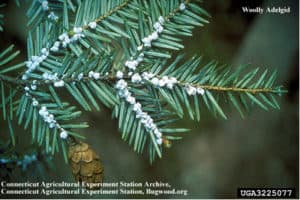 Description: The hemlock woolly adelgid (HWA) is a small (1/32 inch), reddish purple, aphid-like insect that covers itself with a white, fluffy secretion. It is a fluid-feeding insect that feeds on hemlock trees throughout eastern North America, including North Carolina. It may also inject toxins into the tree as it feeds, accelerating needle drop and branch dieback. Wind, animals (especially birds) and humans disperse this insect.
Description: The hemlock woolly adelgid (HWA) is a small (1/32 inch), reddish purple, aphid-like insect that covers itself with a white, fluffy secretion. It is a fluid-feeding insect that feeds on hemlock trees throughout eastern North America, including North Carolina. It may also inject toxins into the tree as it feeds, accelerating needle drop and branch dieback. Wind, animals (especially birds) and humans disperse this insect.
Symptoms: Hemlocks that have been affected by HWA often have a grayish-green appearance. Infested hemlocks become covered with dirty white globs of cottony puffs. Infested trees defoliate prematurely and may die eventually.
The HWA over winters as a female within the cottony puffs. Egg laying begins in February with females laying between 100 and 300 eggs in the woolly egg sacs beneath the branches. Tiny crawlers hatch from the eggs in April and May and settle down to feed. Once settled at the base of the hemlock needles, crawlers become immobile nymphs which feed and mature into wingless or winged adult females by early summer. The wingless form lays another 100 to 300 eggs on hemlock. Crawlers emerge from these eggs to search for suitable feeding sites. Once settled, around July, these young nymphs spend most of the summer as tiny black insects with white fringe. In October or November, they molt, grow and produce the cottony puffs. Feeding continues throughout the winter and early spring.
Action: A good time to attempt control of the HWA is in October when the second generation begins to develop. The insecticidal soap and the horticultural oil sprays seem to be very effective for adelgid control with minimal harm to natural predators and parasites of this pest. Trees that are heavily infested and are showing symptoms of decline should be sprayed. In order for these to be effective, the application must be thorough throughout the entire plant and may need to be reapplied later in the growing season. It is essential to kill virtually all of the HWA on a plant or the population will soon appear at unacceptable levels. Horticultural spray oil can be applied during the winter and before new growth emerges in spring. Oil sprays may damage hemlock during the growing season, especially in dry weather.
Another effective method that has been shown to achieve very good results is a systemic that gives year long control.
Once this pest is in any given area, it will constantly pose a threat to all hemlock, even those that have been treated. Therefore, all hemlocks in these areas should be monitored carefully several times a year and treatments applied when found.
Thank you for reviewing this information. Schneider Tree Care is committed to preserving and enhancing the quality of your property through tree care education and services. We employ professionally trained and certified arborists who are available to meet with you for a consultation at no charge.
If you have any questions or need additional information regarding the health of your trees, please contact us.





